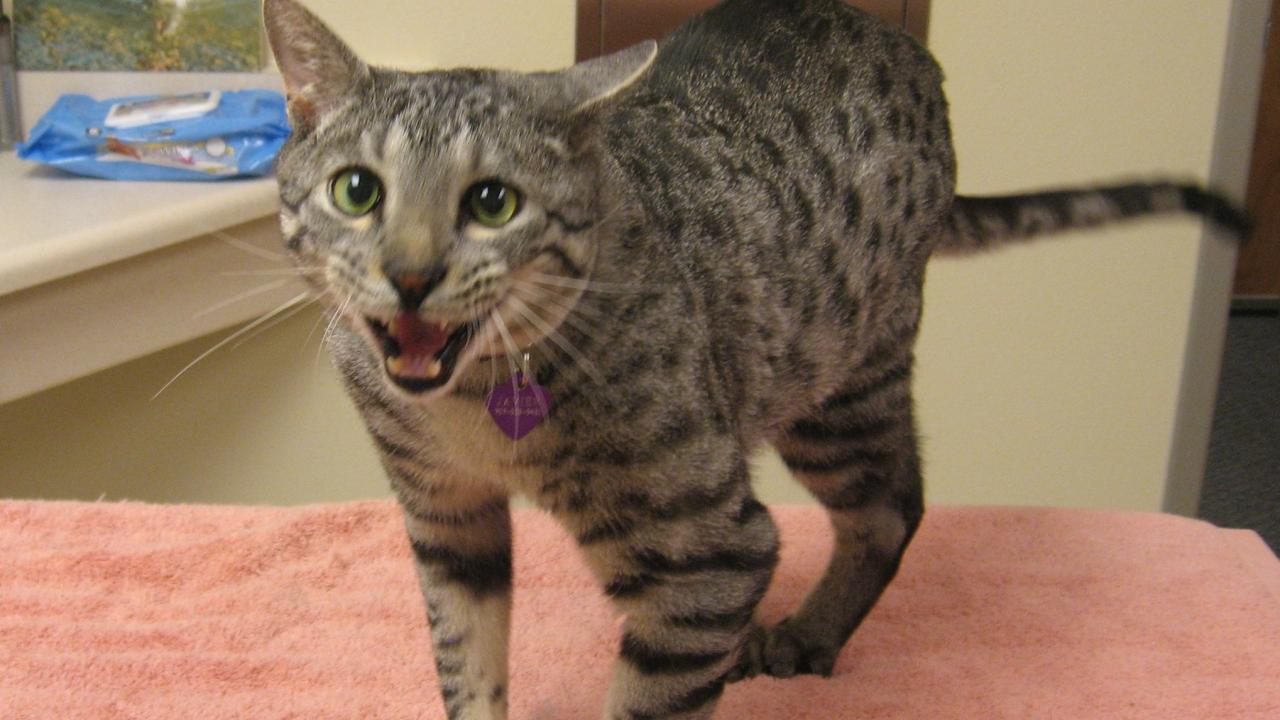
Use of Hydrotherapy Combined with Antibiotics Showed Promise in Cat with Rare Tissue Disorder
Treatment Plan Greatly Extended Cat’s Life
***This recently published case study was the result of treatment on a cat by the UC Davis veterinary team from 2006-09. Recently, a UC Davis veterinary student took interest in the “cold case” and published the results.***
Life for Javier was not looking up in 2006. The 10-month-old male Savannah cat’s health was declining, and he was referred to specialists at the UC Davis veterinary hospital after showing abnormalities in his gait and having multiple masses form in his soft tissues. Javier was diagnosed with fibrodysplasia ossificans progressiva (FOP), a condition that is so rare it only affects one in 1 million people, and literature on it in veterinary medicine is extremely limited. But a collaborative effort by a UC Davis veterinary team led to a unique treatment that has finally been documented with a case study published in ScienceDirect Journal.
FOP is a rare genetic disorder seen in cats and humans in which tissues (such as muscles, tendons, and ligaments) slowly ossify, becoming bone. As its name indicates, it progressively debilitates its victims, who ultimately succumb to it. Many cats with FOP are humanely euthanized within just a few weeks of diagnosis due to disabling pain and mobility problems. But thanks to a unique treatment plan, Javier lived for three years with good quality of life.
The veterinarian on Javier’s case when he arrived at UC Davis in 2006 was Dr. Autumn Davidson, a clinical professor in small animal internal medicine who is still with the school.
“FOP is quite rare, and several different treatments were used on the few cats highlighted in the limited literature that we found,” Davidson said. “But none showed improvement with any of the treatments, so we knew we had to get creative if we were to give Javier any quality of life.”
After confirmation of the diagnosis with the assistance of now retired UC Davis bone pathologist Dr. Roy Pool, Davidson discussed potential drugs with now retired UC Davis pharmacist Valerie Wiebe. Wiebe suggested trying enrofloxacin, an antibiotic that could potentially slow down the ossification of Javier’s soft tissues. Enrofloxacin is a fluoroquinolone, a group of antibiotics that are known to inhibit bone growth in puppies, which could possibly slow the progression of FOP.
So, the team commenced on a plan to combine the use of enrofloxacin with physical activity to help Javier’s joints. Davidson also worked with a specialty clinic in the Bay Area that had an active physical therapy (PT) department with an underwater treadmill and a PT specialty technician, Juli Dell’Era, RVT, CCRP, who worked extensively with Javier over the next three years to help improve his joint mobility.
After every water session, Javier’s physical capabilities and comfort levels were evaluated by rehabilitation specialists and his owner. The assessments included observations of his endurance, range of motion (ROM), gait, coordination, pain level, and much more. Throughout the three years of treatment, Javier showed an improved ROM and endurance.
Davidson is confident that the drugs and PT worked toward their goal, simply based on the fact that Javier lived so long after diagnosis when most cats succumb in less than a year. Javier died suddenly in 2009 of heart failure, which may or may not have been related to FOP.
Unfortunately, publishing this case study of 14 years ago proved difficult due to time constraints and other roadblocks.
“His improvement with hydrotherapy and enrofloxacin was remarkable, but without a control group and other treated cats, we knew scientific publication would be challenging,” said Davidson.
The case report never transpired, but years later, veterinary student Kim Jacobsen heard about Javier while talking to Wiebe during her work in the UC Davis veterinary hospital’s pharmacy. Jacobsen became interested in reviving an attempt to publish the case.
“I had recently adopted a cat that had her own chronic orthopedic condition,” said Jacobsen. “So, I deeply empathized with Javier’s owner’s unending determination to do everything she could to improve the health and comfort of her beloved pet.”
But again, there were difficulties in getting the case to publication, as it became problematic finding a journal willing to accept it. FOP is so rare in veterinary medicine that the publications could not find experts willing to review the manuscript. Old videos of the hydrotherapy sessions needed upgrading, undertaken by Tim Samartino, a UC Davis information technology specialist. Dell’Era agreed to provide a voiceover documenting Javier’s therapy. Dr. Brian Murphy, a professor of pathology at UC Davis, recovered saved biopsy specimens for genetic testing now available.
“We persevered and finally got it reviewed and accepted,” said Davidson. “I’m thrilled to finally have this important work see the light of day and for other veterinarians and cat owners to know that there is a bit of hope to be found with this devastating condition.”
“This case was particularly intriguing to me due to its comparative medicine implications,” said Jacobsen. “As someone passionate about pursuing a OneHealth approach to disease management and medicine, I saw Javier’s case as important not only for improving the care of feline FOP patients, but also for providing valuable information that could hopefully benefit human patients suffering from this condition.”
Jacobsen has since completed her DVM degree and is currently a PhD candidate at UC Davis.
This study is the first known report of a treatment for cats with FOP that led to improved mobility and significant survival time, and the first report of FOP in an exotic breed cat.
# # #
